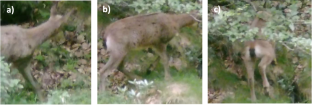DeepFaune计划:在相机陷阱图像中自动识别欧洲动物的合作努力
IF 1.8
3区 生物学
Q3 ECOLOGY
引用次数: 0
摘要
相机陷阱已经彻底改变了生态学家监测野生动物的方式,但只有当收集到的数十万张图像可以在最少的人为干预下轻松分类时,它们的全部潜力才能实现。深度学习分类模型在这方面取得了非凡的进展,但经过训练的模型仍然很少,现在才出现在欧洲的动物群中。我们报道了DeepFaune计划的第一个里程碑(https://www.deepfaune.cnrs.fr),这是一个涉及法国野生动物研究、保护和管理的50多个合作伙伴之间的大规模合作。我们开发了一个分类模型,可以识别欧洲常见的26种或更高级别的分类群,重点是哺乳动物。该分类模型的验证准确率为0.97,许多类别的准确率和召回率通常> 0.95。当在独立的样本外数据集上测试时,这些性能通常高于0.90,我们使用图像序列中包含的图像冗余。我们在一个软件中实现了我们的模型,用于对本地存储在个人电脑上的图像进行分类,从而为野生动物从业者提供一个免费的、用户友好的、高性能的相机陷阱图像自动分类工具。DeepFaune计划是一个持续的项目,有新的合作伙伴定期加入,这使我们能够不断地向分类模型添加新物种。本文章由计算机程序翻译,如有差异,请以英文原文为准。

The DeepFaune initiative: a collaborative effort towards the automatic identification of European fauna in camera trap images
Camera traps have revolutionized how ecologists monitor wildlife, but their full potential is realized only when the hundreds of thousands of collected images can be readily classified with minimal human intervention. Deep learning classification models have allowed extraordinary progress towards this end, but trained models remain rare and are only now emerging for European fauna. We report on the first milestone of the DeepFaune initiative ( https://www.deepfaune.cnrs.fr ), a large-scale collaboration between more than 50 partners involved in wildlife research, conservation and management in France. We developed a classification model trained to recognize 26 species or higher-level taxa that are common in Europe, with an emphasis on mammals. The classification model achieved 0.97 validation accuracy and often > 0.95 precision and recall for many classes. These performances were generally higher than 0.90 when tested on independent out-of-sample datasets for which we used image redundancy contained in sequences of images. We implemented our model in a software to classify images stored locally on a personal computer, so as to provide a free, user-friendly, and high-performance tool for wildlife practitioners to automatically classify camera trap images. The DeepFaune initiative is an ongoing project, with new partners joining regularly, which allows us to continuously add new species to the classification model.
求助全文
通过发布文献求助,成功后即可免费获取论文全文。
去求助
来源期刊
CiteScore
3.40
自引率
5.00%
发文量
68
审稿时长
2 months
期刊介绍:
European Journal of Wildlife Research focuses on all aspects of wildlife biology. Main areas are: applied wildlife ecology; diseases affecting wildlife population dynamics, conservation, economy or public health; ecotoxicology; management for conservation, hunting or pest control; population genetics; and the sustainable use of wildlife as a natural resource. Contributions to socio-cultural aspects of human-wildlife relationships and to the history and sociology of hunting will also be considered.

 求助内容:
求助内容: 应助结果提醒方式:
应助结果提醒方式:


